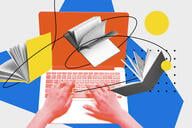You have /5 articles left.
Sign up for a free account or log in.
Higher education’s image problems include skepticism about the value of research conducted at public universities. And research on climate change often is viewed through a partisan lens, with many Republicans questioning the underlying science and even the problem’s existence.
Against this backdrop, Indiana University has taken an unusual approach with a new $55 million research project on environmental change in the state. The idea, leaders of the effort said, is to connect research in the natural and social sciences to the lives and work of people in Indiana, with a focus on proactive and practical ways to cope with climate disruption and related problems.
“We have not always done the full job of explaining what a research university does,” said Fred Cate, the university’s vice president for research. Often unanswered, he said, are questions such as: “Why is research important? Why is it expensive? Why is failure part of it?”
The ambitious environmental change project is the university’s second multidisciplinary research investment to tackle a “grand challenge,” following an ongoing attempt to better treat and prevent human diseases. Over all, the university plans to spend $300 million on its grand challenges.
The University of California, Los Angeles, began a similar research initiative in 2012, with grand challenges on depression and a sustainable LA. Those projects are largely funded by industries and foundations. IU is paying for its environmental change research.
Pedro Ribeiro, spokesman for the Association of American Universities, a research-focused university membership group, praised the two universities and said the grand-challenge approach could be the beginning of a promising trend.
“They explain the benefit of the work to the residents of the state,” said Ribeiro. “This brings people along for the whole process.”
Begun in May, Indiana University’s multidisciplinary environmental change project will feature the hiring of 16 new faculty members and will fund the work of dozens of students each year on the university’s Bloomington and Indianapolis campuses.
Here’s how the university makes the case for this work to its home state, which is deeply conservative and where many politicians are skeptical about climate change: “Indiana faces a unique set of challenges triggered by rapid environmental change. These challenges threaten the vitality of Hoosier businesses, agriculture, jobs and physical well-being,” the university said on the home site for its grand challenge.
The project touts its use of data, not ideology, to bring home the problem’s scope.
The environmental change site notes that extreme weather events have cost Indiana $6 billion in the last five years alone, including damage from floods, tornadoes and winter storms. Temperatures across the state are projected to rise by 4 degrees by 2050 and the Great Lakes will be an estimated 7 degrees warmer by then, threatening agriculture and water quality. And since 2001, shorter and less intense winters have contributed to a 430 percent increase in documented cases of Lyme disease.
“We know our climate is warming, causing heavier spring flooding and hotter, drier summers. But these visible effects of climate change also give rise to less obvious environmental changes,” the university website said. “Growing seasons are shifting. New migratory patterns are emerging. The topography of Indiana's landscape is changing. The effects are cumulative and wide-ranging. They impact not only our local ecosystems, but also our economy and health. And they threaten to change key pillars of life in our state.”
The language on the site is matter-of-fact, with no quotes from Al Gore and a focus on practical solutions for Hoosiers.
Data and Clear Goals
On the natural sciences front, university researchers plan to create predictive modeling for changes in climate, water dynamics and vegetation and wildlife. The goal is to help local governments, businesses and nonprofit groups plan for investments in agriculture, industry, infrastructure and public safety.
“We’re starting with an ecological point of view,” said Ellen Ketterson, a distinguished professor of biology at IU who is the project’s team leader. “Everything’s connected and you can’t change just one thing.”
The university is producing targeted environmental change projections for counties across the state. “Reliable information, not preaching,” said Ketterson, the former president of the American Society of Naturalists. An initial step will be the creation of a forecasting tool, dubbed the Hoosier Resiliency Index, which will track the readiness of locales to respond to immediate and long-term elements of environmental change.
A key part of the project will be the forging of partnerships with local politicians, utilities, rotary groups and many others to use the research in practical and economically viable ways. One pilot program, for example, will focus on the lower Wabash River and feature the creation of a “decision-support matrix” to help landowners forecast soil and water conditions as well as economic returns on crops and timber.
Cummins Inc. is a large, Indiana-based manufacturer of diesel and alternative fuel engines that employs 10,000 people across the state. The company is an early partner with IU on the environmental change project. Jon Mills, a spokesman for Cummins, said the university has made a concerted effort to connect with employers, combining clear goals and good data with a focus on making Indiana more prosperous and sustainable.
“[It’s] the kind of research that’s critical to our future,” Mills said. “Any time you can use data to set goals, it’s easier for companies and communities to use it.”
A multidisciplinary approach is at the core of the grand challenge, said Ketterson.
“It’s going to take people with a lot of different types of expertise,” she said.
Social scientists will research how public opinion, individual and institutional behaviors, and the political landscape factor in as the state copes with environmental change. And research on communicating to the general public and “not speaking from on high” will be an important focus, said Ketterson.
“It’s a huge challenge,” she said of the communications aspect. “I would say it’s a third of our effort.”
The university’s administration has been a strong backer of the work, Ketterson said. Michael McRobbie, IU’s president, created the grand challenge investments in 2015. But Ketterson said the project evolved under the leadership of faculty members.
James Brainard, a Republican, has been mayor of Carmel, Ind., a suburb of 90,000 located just north of Indianapolis, for two decades.
“I have a lot of conversations with skeptics” on climate change, he said in an interview. Even so, Brainard said, skeptics are willing to consider information about it, particularly when the potential impact on jobs is considered. And local business leaders have bought into the issue, he said.
“This isn’t about decreasing the quality of your life. It’s about increasing the quality,” he said. Brainard added that the right approach is specificity and helping explain to people “why we should be taking action. What are we asking them to do?”
While Brainard said the initial outreach from IU doesn’t go “far enough” in assuaging worries about jobs, he praised the university’s overall approach.
“I’m pleased that the university is taking this one,” he said. “Quite honestly I’m surprised that this is coming from IU.”




